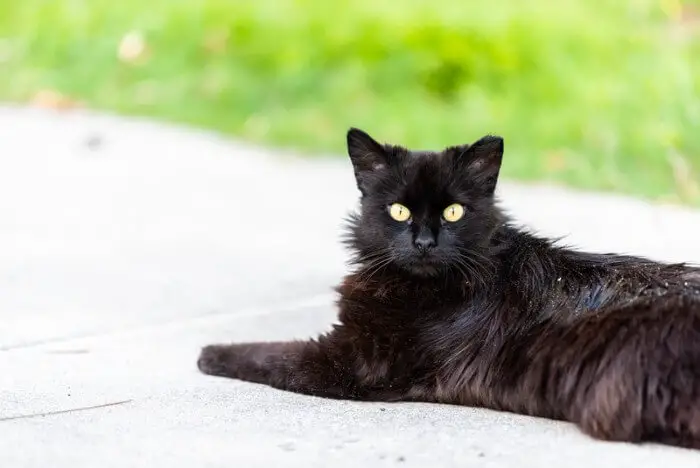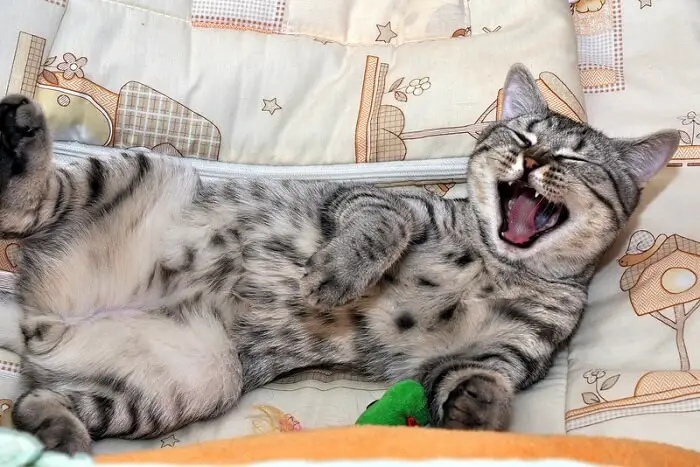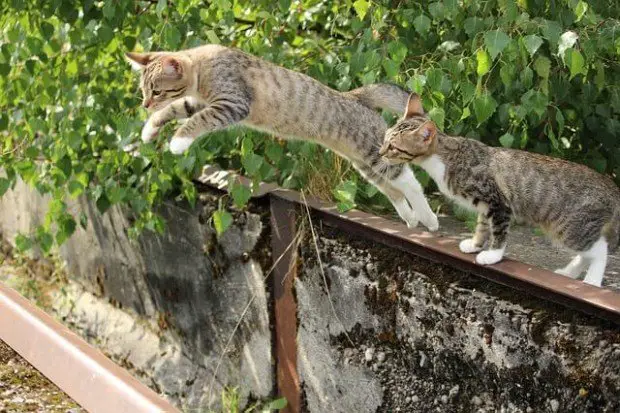Just like humans, cats can suffer from dandruff. Although unsightly, dandruff is actually quite a common issue for cats.
The dry, flaky skin is usually the result of an allergic reaction triggered by the environment, diet or parasites.
Fortunately, dandruff is often not serious and it can be easily treated from the comfort of your home with simple treatments such as bathing them with dry skin shampoo, regular grooming, diet supplements, reducing environmental stress or using a skin moisturizer.
This guide covers what cat dandruff is, what causes it and 10 simple ways to treat it at home.
Contents
What is Cat Dandruff?

Cat dandruff is quite a common issue, it’s typically not serious but it can be uncomfortable for your cat and it may be a symptom of an underlying issue.
Dandruff is characterized as a collection of dead skin cells that have flaked away from your cat’s skin, it occurs when their skin is abnormally dry and itchy.
You may notice white specks scattered throughout your cat’s fur and even on their bedding. If you look closely at your cat’s skin you might be able to see it is dry or inflamed.
Your cat could also be itching or grooming more than usual which could lead to hair loss and bald patches.
“Despite cat dandruff not being serious or life-threatening, it is an extremely common skin condition. Most cases are diagnosed in pets that have dry and itchy skin, which can be a large portion of the cat population. The majority of cats will experience dandruff at least once in their life. “
Cristina Vulpe, Veterinarian
Is Dandruff the Same as Dander?
No, dandruff and dander are not the same. Dander is the normal shedding of tiny skin particles that are so small you are unlikely to be able to see them with the naked eye.
Dander is what often triggers reactions in people with pet allergies.
Dandruff, on the other hand, is larger white flakes that you can see in your cat’s fur. Dandruff is caused by dry, itchy skin and is often due to an allergic reaction triggered by something such as environmental factors or food.
Potential Causes of Cat Dandruff
There are a selection of potential reasons your cat is suffering from dandruff. The most common reasons are listed below:
- Infection such as ringworm
- Poor quality or unbalanced diet
- Warm and/or dry environment
- External parasites such as mites, ticks and fleas
- Allergies such as food, flea or fabric allergies
- Anxiety or stress
- Sunburn
- Old age or obesity
How to Treat Cat Dandruff at Home
Fortunately, there are many simple steps you can take to treat your cat’s dandruff at home.
Remember that dandruff could be a sign of an underlying infection or disease so a trip to the vet may be necessary to treat any underlying conditions.
Below are the top 10 home treatments for cat dandruff:
1. Bath them using dandruff or dry skin shampoo

One of the most effective ways of helping to remove dandruff and treat skin problems is to use a cat shampoo that has been designed for use on dry skin and dandruff.
Generally, cats don’t need baths however occasional bathing will help keep their coat clean and will moisturize their skin as well as loosen and remove any skin flakes.
Oatmeal and aloe shampoo is a great option for dandruff as it’s a natural solution that heals, soothes and moisturizes without using harsh soaps or ingredients that will further irritate your cat’s skin.
Bathing doesn’t have to be frequent to be effective, a bath every now and then when you notice their coat could do with it is enough. Your vet may also recommend a medicated shampoo to help treat skin issues.
2. Invest in a home humidifier
If you live in a dry, hot climate or it’s noticeably dry at certain times of the year, consider a home humidifier.
A humidifier adds moisture to the air so will improve the moisture level in your home and will provide your cats skin with the extra moisture it needs.
If your cat spends a lot of time indoors and the air is dry it will cause moisture to evaporate from their skin and this plays a role in them having dry, dead skin. A humidifier is a simple and effective way to combat that.
3. Treat for parasites

Bites from external parasites including mites, fleas and lice can cause cats to have an allergic reaction on their skin.
This allergic dermatitis causes itching and dandruff. It is likely if your cat has parasites they will have dandruff too so dealing with the parasites will help handle to skin problems.
There’s a type of mite called Cheyletiella that’s sometimes referred to as “walking dandruff” due to its appearance and the flaking skin it causes. When treating for external parasites don’t forget to clean all bedding and to treat other pets in your home too.
If parasites are a problem for your cat then have a look at our recommended cat flea treatments.
4. Introduce a regular grooming routine
By regularly brushing your cat you are helping to stimulate blood circulation, spread natural oils throughout their coat and promote good skin health.
Brushing with a proper cat brush will help remove dirt, grease, dead skin cells and loose hair.
Introducing regular grooming to your cat’s care routine can help to build your bond and will make it easier for you to spot changes in their coat condition.
If your cat is overweight, elderly or suffers from arthritis it is a good idea to groom them frequently as they won’t be able to groom themselves as effectively as needed.
5. Try new cat food

Dandruff can be caused by a nutritional deficiency, this may mean your cats diet needs to be switched to a higher quality, better-suited cat food.
Look for food with higher levels of quality protein and omega 3. Switching to wet food is a good way to increase your cat’s water intake.
Additionally, keep in mind that your cat’s dandruff could be being caused by an allergy. In this case it is important to eliminate the allergen from your cat’s diet. Some common cat food allergies include corn, dairy, beef and fish.
While we are talking about food, it is also important to make sure they aren’t eating too much and becoming overweight as this will have a negative impact on their health.
6. Use diet supplements
Your cat may be lacking in a certain nutrient.
Adding a supplement to help balance their diet can help; Omega 3 or fish oil are the most common supplement used to help with dry skin as they can help promote natural skin oils and maintain healthy skin and hair.
7. Ensure drinking water is always available

Make sure your cat always has access to clean, freshwater. Their skin may be dry due to dehydration.
If you find your cat is not particularly interested in drinking water from their bowl, consider trying a water fountain which can make water more appealing for your cat.
8. Reduce environmental stressors
Cats can have physical reactions to stress. Renovations, new family members, moving home or just moving furniture are some examples of common environmental changes that can stress a cat.
Stress and anxiety can trigger dry skin and dandruff. If you think your cat is stressed, avoid making sudden changes to their regular routine and keep the house as calm and quiet as possible.
9. Reduce sun exposure

Dandruff could be caused by sunburn as cats can experience sunburn just like humans can. Light-coloured cats or cats with thin fur are more susceptible to sunburn.
Providing more shaded areas for your cat and encouraging them out of the sun during the hottest part of the day can help to heal their skin and prevent sunburn. Keeping your cat indoors can help with this issue.
10. Try cat skin moisturizer
You can buy oils and sprays that soothe and moisturize skin that have been specially designed for use on cats. These moisturisers can be rubbed into your cat’s skin where it is then absorbed.
If you don’t want to buy a cat skin moisturizer, you could use coconut oil. Applying a small amount of coconut oil topically can help with dry skin, itchiness, allergies and coat health.
Although this is not recommended for regular use it can be used as a remedy for dry skin.
Summary

Dandruff is no fun for anyone, it can be sore and irritating causing your cat to itch and scratch excessively. Seeing skin flakes in your cat’s fur and around the house can also be quite off-putting.
While there are many reasons a cat may have dandruff, the solutions are thankfully simple and straightforward.
Increasing the frequency of your cats grooming routine, ensuring they are eating a healthy diet and are hydrated can make a huge difference in the condition of their skin. By implementing the above advice you’ll be cuddling again in no time.
As an Amazon Associate I may earn a small fee from qualifying purchases at no extra cost to you. This helps us run the site, so thanks for your support!







Leave a Comment